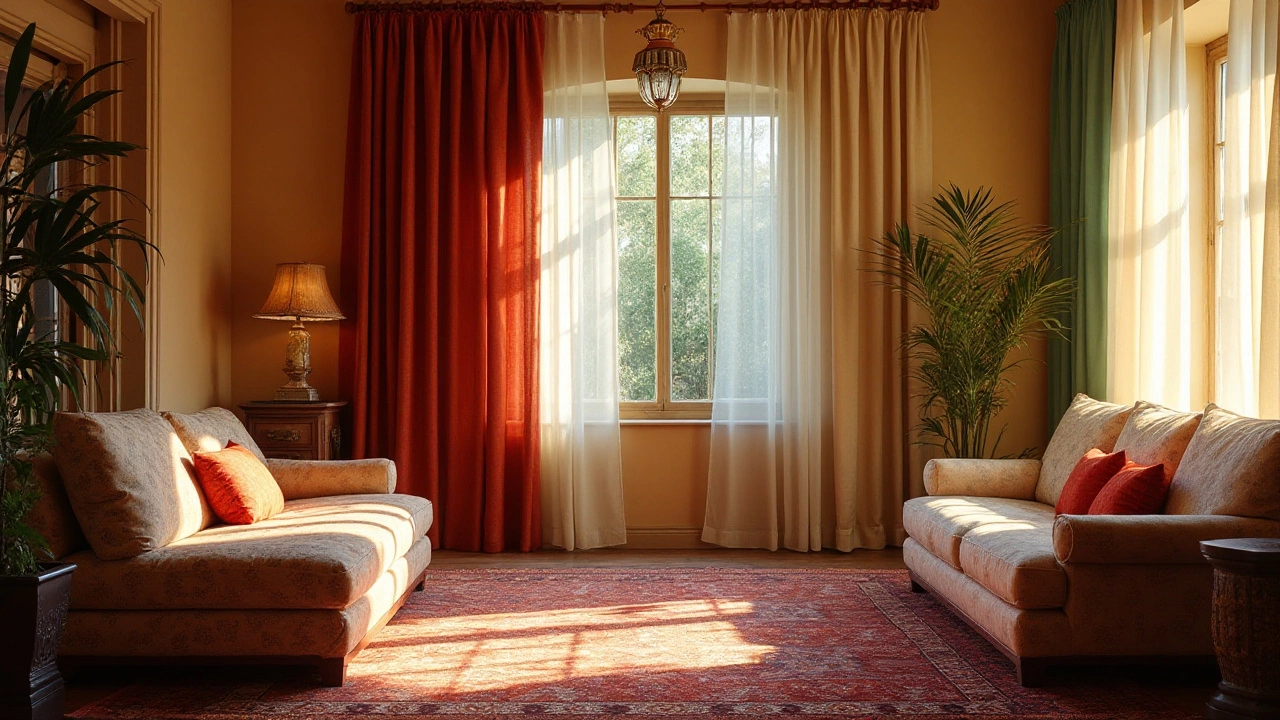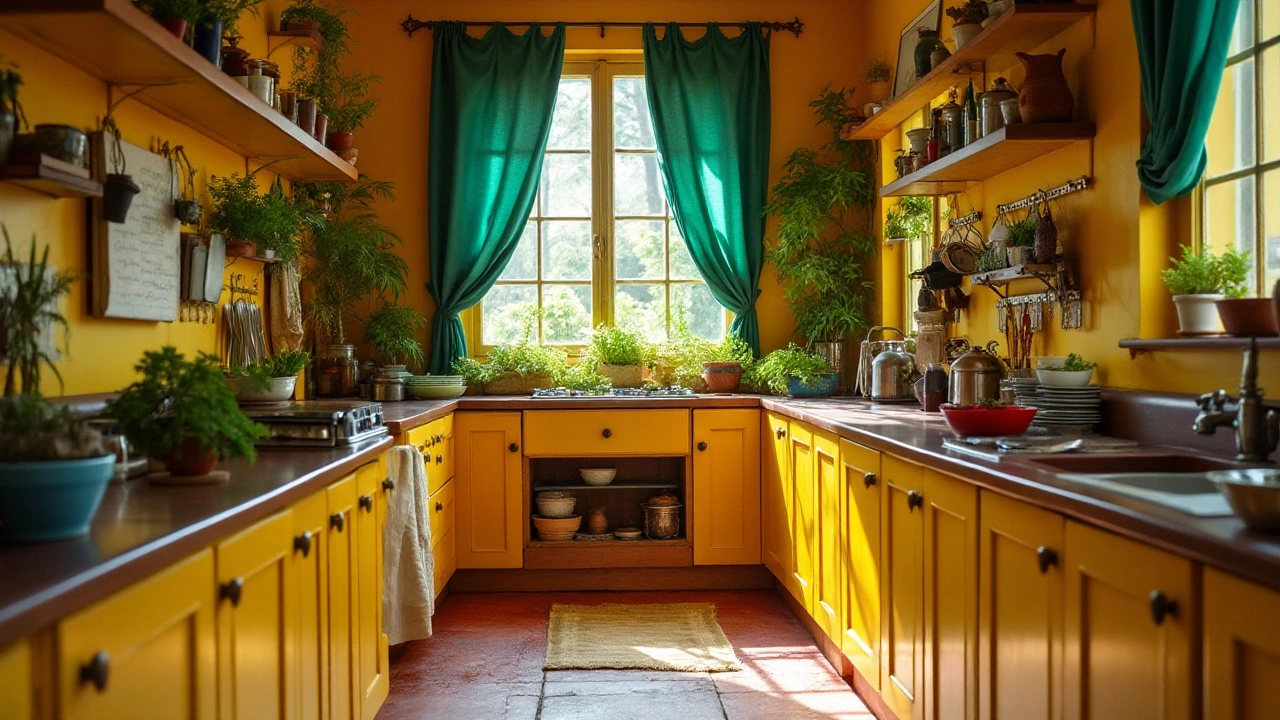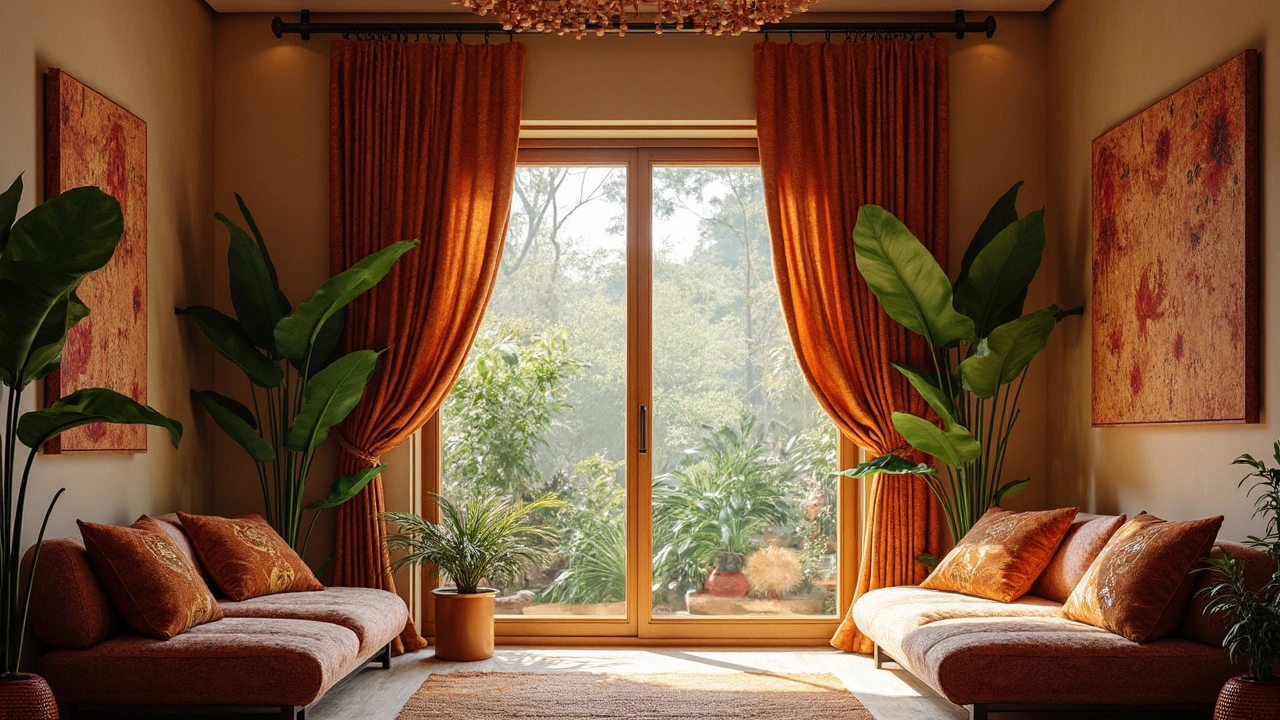Choosing the Right Curtain Color for Your Walls

When you're decorating your home, the color of your curtains can hold as much significance as the artwork on your walls or the furniture in your living room. The right shade can tie everything together, but getting it wrong might throw the whole room out of tune. Should curtains be darker or lighter than walls? This is a question many grapple with—some in pursuit of cozy nooks, others yearning for airy sanctuaries.
In this guide, we'll journey through the world of color and capture its essence in the realm of curtains. Whether you're striving for harmony or contrast, we'll provide insights and tips to help you navigate this vibrant decision. Learn how curtain color choices influence mood, perception, and even the amount of light that graces your living spaces. It's more than just aesthetics; it's about crafting an environment that feels like home.
- Understanding Color Theory Basics
- Darker Curtains: Benefits and Considerations
- Lighter Curtains: Advantages and Drawbacks
- Balancing Light and Space
- Practical Tips for Curtain Selection
Understanding Color Theory Basics
Delving into the world of color theory opens a doorway to understanding how hues can transform any space, creating moods and illusions. At the heart of color theory is the color wheel, a mesmerizing spectrum that artists and designers use to predict interactions between colors. Conceived in the 18th century by Sir Isaac Newton, the color wheel positions colors so that their relationships are easily understood. The wheel is divided into primary, secondary, and tertiary colors, each with its role in creating harmony or contrast.
Primary colors—red, blue, and yellow—are the source of all other hues. When mixed, these emit secondary colors such as green, orange, and purple. Further mixing produces tertiary colors, achieving a complexity that invites creativity. The magic happens when you explore the relationships between these hues—complementary, analogous, and triadic schemes are a few of the arrangements that draw the eye and evoke emotion. Complementary colors, located directly across from each other on the wheel, offer a vibrant contrast, whereas analogous colors provide serenity through adjacency.
Color theory doesn't end with aesthetic synchronicity; it extends into psychological impacts that can influence mood and perception. For instance, warm colors typically foster feelings of warmth and comfort but can also stimulate emotions and conversation. Meanwhile, cool colors tend to be soothing, promoting restfulness and calm. Knowing this, choosing a curtain color that interacts intentionally with your wall paint can create a perfect balance, promoting whichever mood you desire in a room.
Consider this: the way colors affect light and space is vital. Light colors tend to reflect light, making spaces feel airy and larger, whereas dark colors absorb light, creating a cozier and more intimate atmosphere. An interesting fact is that certain cultures and philosophies prescribe colors for specific meanings and uses. In Feng Shui, for instance, colors have attributes linked to the five elements, with certain colors bringing prosperity, health, or joy when balanced correctly within a space.
“Color is a power which directly influences the soul,” proclaims artist Wassily Kandinsky, no stranger to the emotional language of colors.
The interplay of colors—through the lens of the color wheel and psychological effects—forms a fundamental aspect of any design decision. When choosing whether your curtain color should be darker or lighter than your walls, understanding these basics can serve as a beneficial guide. Equip yourself with knowledge of how colors interact and affect both spaces and emotions, allowing you to make informed decisions that will create harmony within your living environment, tailored precisely to your personal taste and the desired ambiance.
Darker Curtains: Benefits and Considerations
Darker curtains have a unique ability to add depth and warmth to a space that lighter tones might not achieve. When chosen thoughtfully, these rich hues can anchor a room, providing a sense of coziness and intimacy that invites relaxation. Imagine a deep navy curtain against soft gray walls—it can transform a stark room into a serene retreat. Interestingly, dark curtains are not just about aesthetics; they are highly functional. They can effectively block out more light, which is particularly beneficial for bedrooms or media rooms where controlling natural light exposure is crucial for comfort and enjoyment.
The question of curtain color often boils down to practicalities as well. Darker shades are generally more forgiving when it comes to maintenance. They typically hide stains and dirt better than lighter curtains, making them an excellent choice for homes with children or pets. However, there's a flip side to consider. Dark curtains can absorb more heat, so in a room that gets a lot of sun, they might contribute to a warmer environment. It's essential to pair them with appropriate materials to mitigate this effect.
"When choosing curtains, consider both function and aesthetics. Dark curtains can set the mood and offer practical advantages, but ensure they complement the rest of your decor." – Interior Design Magazine
Aesthetic Considerations
In terms of aesthetics, darker curtains offer a bold way to incorporate color without overwhelming the space. They can also act as a dramatic backdrop that highlights other design elements like artwork or furniture. If your walls are painted in neutral shades, a dark curtain can add a pop of color or contrast without overpowering the existing decor. Engaging in a little visual experimentation can lead to spectacular results. For instance, pairing a rich emerald curtain with cream walls might not only upgrade the room's look but also create an artful balance that stays relevant through passing trends.
There's a strategic element at play here, too. Dark curtains can visually reduce the size of a room, so they're often better suited for larger spaces unless you're intentionally creating a snug, enclosed feel. In smaller rooms, using a dual-layer approach, like adding sheer curtains beneath darker drapes, can offer flexibility in lighting and ambiance. This way, during the day, you can pull back the dark layer for a more open feel, while at night, you can close them for privacy and darkness. Exploring these layers can enhance both usability and style.
For those seeking a curated home decor look, consider the role of complementing accessories. Employing darker curtains in tandem with coordinating cushions or a plush area rug can unify a room's theme. It's about crafting a cohesive narrative within your space, where every element communicates a deliberate style choice. And when carefully selected, the impact of darker curtains is not merely visual—it's experiential. They can cocoon you in warmth, setting the perfect tone for a cozy winter evening or a chilled-out movie night.
| Benefit | Consideration |
|---|---|
| Blocks out light effectively | May absorb more heat in sunny rooms |
| Low maintenance and stain-hiding | Potentially reduce perceived room size |

Lighter Curtains: Advantages and Drawbacks
Choosing lighter curtains can transform the ambiance of a home, guiding natural light in a way that's both subtle and nurturing. In essence, light-colored curtains have the innate ability to open up a room, creating an illusion of more space. This visual effect is particularly beneficial in smaller rooms or apartments where space is a premium. The interaction between light curtains and direct sunlight can be magical, often allowing a soft, diffused glow to filter through, gently illuminating every corner. This enhances the sense of warmth and airiness, which can be perfect for living rooms and bedrooms alike.
Moreover, lighter curtains often pair well with various wall colors, providing a neutral backdrop that doesn’t overpower the room. They can harmonize beautifully with both bold and muted palettes, lending flexibility in design choices. An interesting point is that lighter curtains can also be instrumental in highlighting other decor elements. Whether it be a vibrant piece of furniture or an exquisite piece of art, lighter curtains ensure that the attention remains on these focal points rather than the windows themselves. Curtain color matters when your goals include showcasing that prized vintage armchair or that invigorating abstract painting.
On the flip side, there are drawbacks to consider. Light-colored curtains can often show dirt and stains much more readily than their darker counterparts. This might lead some homeowners to shy away from lighter options due to the potential upkeep involved. Regular cleaning can become a necessity rather than an option, especially in homes with young children or pets. The material can also affect this; natural fabrics like cotton or linen tend to absorb more dirt and dust.
As the renowned interior designer Nate Berkus once mentioned, "Design is about the balance of space, light, and soul." Lighter curtains manifest this balance, provided they're maintained well.
Privacy might be another consideration. Lighter curtains, especially when unlined, can offer less privacy than darker or heavier fabrics. This might not be ideal for ground-floor windows or urban areas where neighbors are close by. Some may choose to compromise with layered options, such as pairing sheer light curtains with heavier drapes for moments when more privacy is needed. When considering energy efficiency, remember that lighter colors may not insulate as well as dark ones, potentially letting more heat escape during colder months. To counter this, some might opt for thermal linings.
The decision to use light-colored curtains is always context-driven. It's important to weigh both the aesthetic and practical sides, keeping in mind the interior design goals and the daily needs of the household. Ultimately, while lighter curtains can imbue spaces with a sense of openness and lightness, they also demand care and thoughtful placement to truly shine.
Balancing Light and Space
In the delicate dance of home decor, achieving a sense of balance between light and space can transform a room from drab to delightful. The way you choose to manipulate these elements can either open up a small room or create a cozy nook in a larger area. The first thing to consider when selecting curtains is how they will interact with the light. Natural light is one of the most coveted attributes in a home, bringing with it warmth and a connection to the outside world. Curtains that are lighter in color can enhance this natural light, allowing it to filter gently into the space, creating a soft and warm glow. On the other hand, darker curtains can absorb more light, reducing glare and creating a more intimate and subdued atmosphere. This effect can be particularly appealing in rooms meant for relaxation, such as bedrooms or dens.
Space perception is equally important. Lighter colors tend to make a room feel more expansive, as they reflect more light and can visually push walls back. This can be a strategic choice for smaller spaces where every inch counts. Opting for lighter curtains against light walls can further this illusion, creating a seamless flow of space that feels airy, almost like a breath of fresh air. Conversely, using darker curtains against lighter walls can add a striking visual contrast that may ground a room, making it feel more anchored and robust. This technique is especially beneficial in larger spaces that risk feeling too open or impersonal.
"The colors around you have deep impact on your psyche and physiology," explains Karen Haller, a prominent color psychologist, "Understanding the balance between light and dark can heighten the design experience of any room, aligning emotions with the intended vibe."
For those who marvel at the intersection of aesthetic appeal and practical use, there are additional considerations. The material and texture of the curtains themselves can play into this balance. Heavy fabrics in darker tones can block light completely, perfect for blackout curtains that encourage deep sleep. In contrast, sheer or lightly woven materials in brighter hues allow for light diffusion, ideal for sun-soaked afternoons in the living room. Using such fabrics strategically can optimize lighting conditions without sacrificing style. Regularly reassessing the effects of light on your space according to time of day and season can inspire ongoing adjustments, keeping your home vibrant and responsive to natural changes.
When we consider the way light and space can be manipulated through curtain choices, we begin to see that it's not just about color. Texture, material, and placement also play their parts in this symphony. By understanding these elements and how they interact, one can create the perfect ambiance, whether it’s bright and open or cozy and intimate. Your selection should encapsulate both personal style and practical necessity, reflecting an understanding of these dynamics. Each room is unique, and so, too, should be the relationship it shares with its light and space—a relationship nurtured by the thoughtful choice of curtains.

Practical Tips for Curtain Selection
When it comes to selecting the perfect curtains for your home, several factors should be considered to ensure the outcome is visually appealing and suits your lifestyle. The weight and fabric of your curtains can significantly affect not only their appearance but also their functionality. For example, if you're aiming to block out sunlight in a bedroom, opting for heavier materials like velvet or blackout fabrics can be highly effective. On the other hand, lighter materials such as sheer or linen may be more appropriate for living areas where natural light is welcomed.
Color choice is another crucial aspect, especially in relation to the hues and tones of your walls. One suggestion is to use the curtain color as an accent in the room, which can create a cohesive and well-thought-out space. To achieve this, consider picking a color that appears in other elements of the décor such as a piece of art or a rug. This strategy not only brings harmony but elevates the room's style. It's essential, however, to remember that darker colors tend to make a space feel smaller and can absorb light, whereas lighter colors can create an illusion of space by reflecting light.
Layering and Textures
Layering curtains is a method that diversifies both style and functionality. A popular choice is combining sheer curtains with a heavier drape. This adds depth and texture while offering options for privacy and light control. You may draw back the heavy curtains during the day to let in sunlight, while the sheers maintain privacy without blocking too much light. This not only increases the potential usage of the area depending on the time of day but also amplifies aesthetic flexibility.Patterns also play a significant role in the final look. If the walls are plain, patterned home decor items can add interest without overwhelming the senses. Too many patterns can create chaos, while too few might lead to a dull atmosphere. A balanced approach can breathe life into your space, as interior design often thrives on thoughtful contrasts and nuances.
Measurements Matter
One practical tip often underestimated is the importance of precise measurements. Ensure the curtains are not only the right width to ensure proper coverage and gathering but also the appropriate length. Curtains that touch the floor or mimic the height can add an element of luxury and make the ceilings appear higher. The width should adequately cover the window frame and allow for a pleasing drape when drawn. It's suggested to multiply the window width by 1.5 to 3 times for full coverage.
"The details are not the details. They make the design," says Charles Eames, a notable figure in architecture and design. Perfecting these small facets can elevate the ordinary to the extraordinary in home decor.
Understanding how your choice of curtain relates to your walls can transform your living space into something that conveys personal style while also being practical. Whether you aim for a bold look with contrasting colors or a serene flow with harmonizing shades, keep these tips in mind as you explore the colorful world of interior design.


